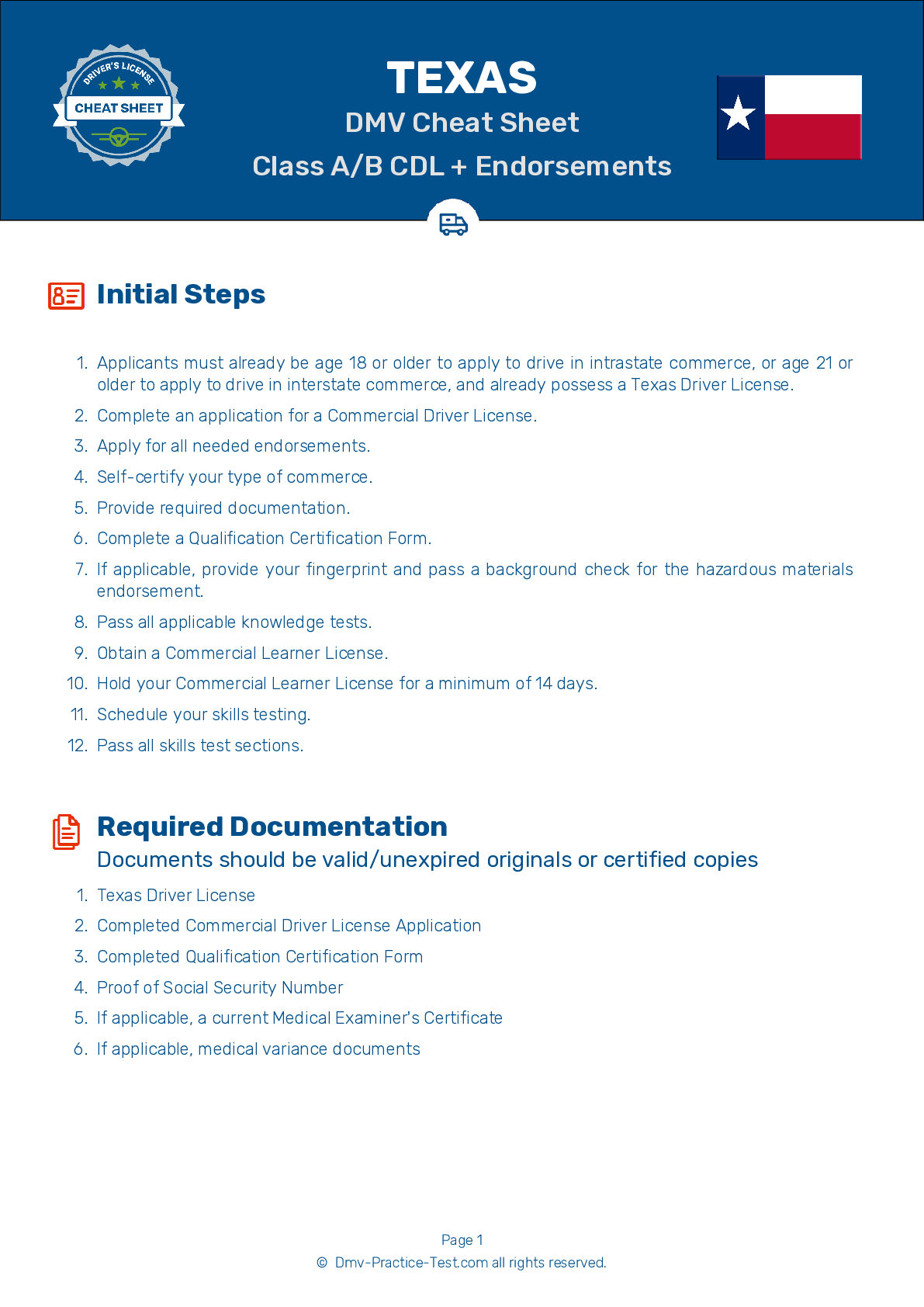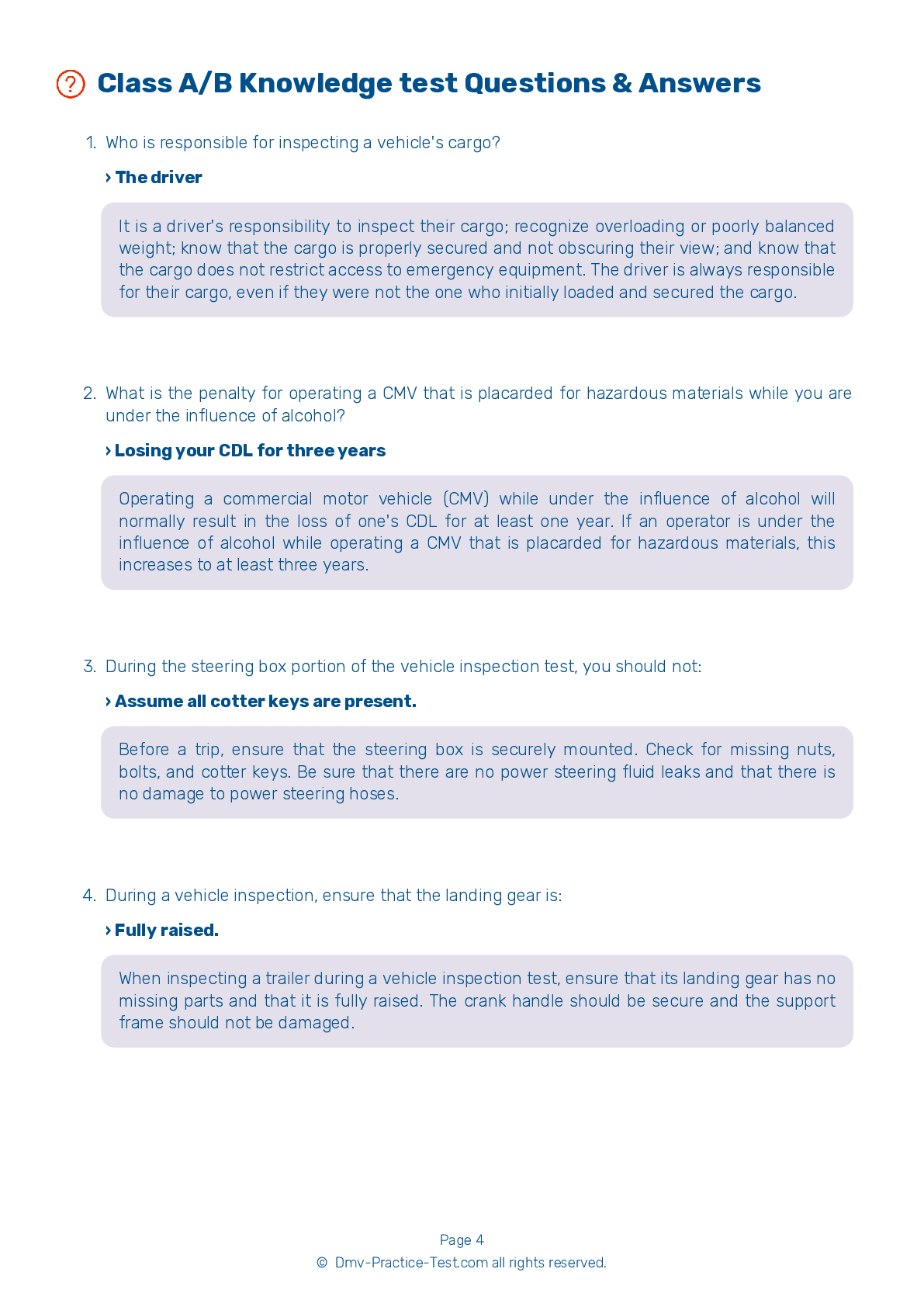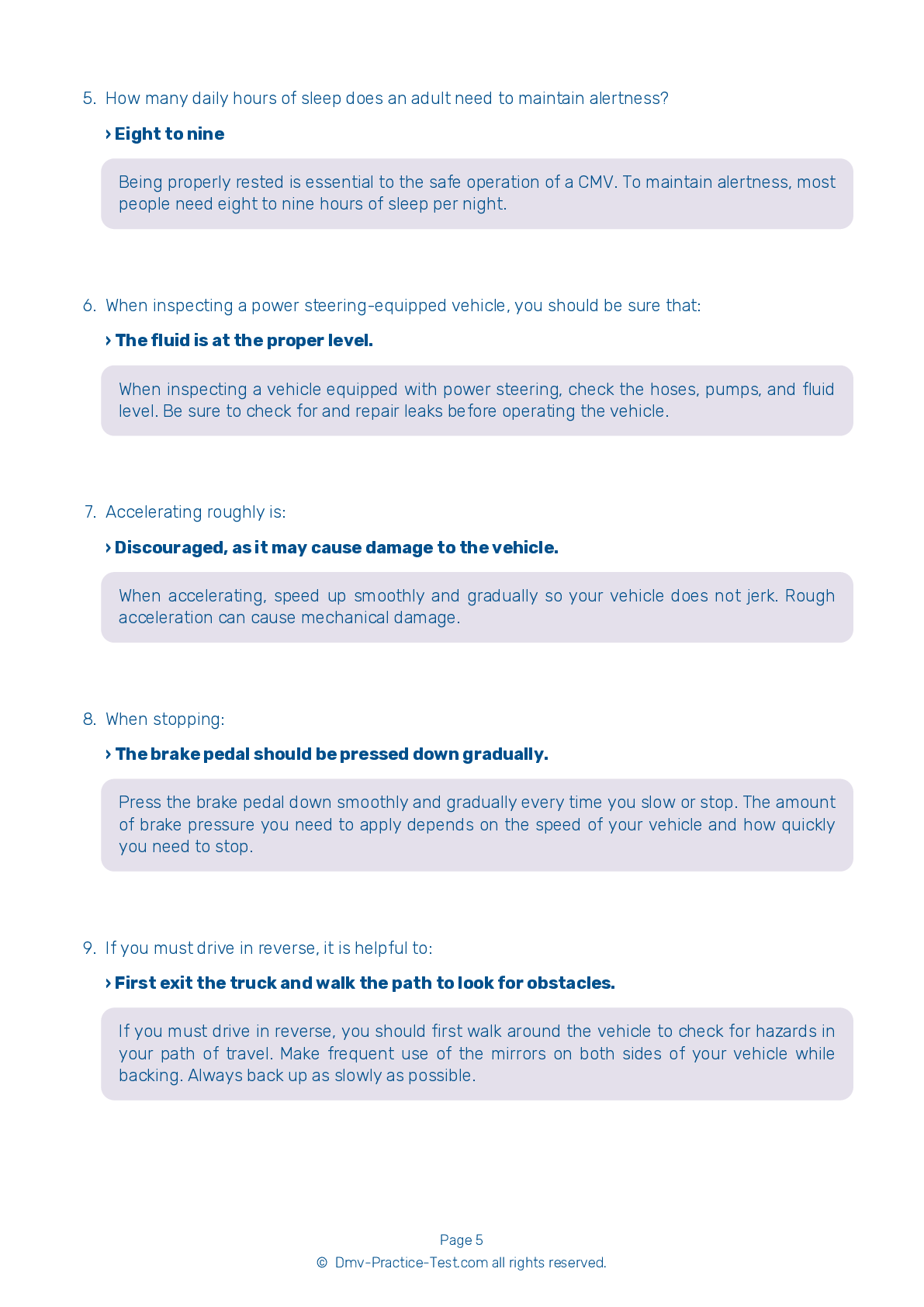Knowledge Test Class A #1
Class A Driving Test | Texas 2025 #1 Page 5 of 10
Train for FREE online with our Texas class A license test. The official exam test consists of several obligatory parts, with all of them checking your knowledge of different blocks of road rules. If you need to obtain a TX CDL class A permit in 2025, practice as much as possible. Free sample tests published on our website will help you check and improve your knowledge and boost your grades. Please bear in mind that CDL class A requirements may vary from state to state.
70
56
22
29 . When making a tight maneuver, you should:
Rely only on your mirrors.
Make a point of checking your mirrors often when making tight maneuvers.
30 . To ensure normal stopping power, drivers of vehicles equipped with a front brake limiting valve should:
Keep the control at the halfway mark.
Some pre-1975 vehicles have a front brake limiting valve, which has "normal" and "slippery" settings. The idea behind these valves was to limit the air pressure available to the front brakes when driving on slippery surfaces, and thereby reduce the danger of a front-wheel skid. Studies have found that this is not actually a concern, so if your vehicle has a front brake limiting valve, leave it in the "normal" position.
31 . During an applied leakage test, the maximum leakage rate for a single vehicle with air brakes is:
4 psi in one minute.
It is important to know the maximum air loss rate that is safe for your specific vehicle. A single vehicle with air brakes should have a leakage rate no higher than 3 psi in a minute during an applied leakage test.
32 . What color are ABS malfunction lamps?
Blue
Vehicles with Anti-Lock Braking Systems (ABS) have yellow malfunction lamps.
33 . If you need to travel down a hill, you should switch into a lower gear:
Near the bottom of the hill.
Always downshift before beginning to drive downhill. Forcing an automatic transmission into a lower gear at a high speed could damage the transmission and also lead to a loss of ability to engine brake. Drive at a speed that will allow you to control your vehicle without overusing your brakes. When determining a safe speed to drive, you should take into account the steepness of the grade, the length of the grade, the weight of your vehicle, road conditions, and weather conditions.
34 . Which of the following is not a part of an air brake system?
An axle brake system
Air brakes consists of three separate braking systems: the service brake system, the parking brake system, and the emergency brake system.
35 . If the low pressure warning light comes on while you are driving:
You should continue driving, but turn the emergency flashers on to warn other motorists.
If the low air pressure warning light turns on, you should stop and safely park your vehicle as soon as possible. Controlled braking will be possible only as long as enough air remains in the tanks.
2025 Texas | Frequently Asked Questions
A CDL Class A license in Texas permits drivers to operate any combination of vehicles with a Gross Combination Weight Rating (GCWR) of 26,001 pounds or more, provided the Gross Vehicle Weight Rating (GVWR) of the vehicle(s) being towed is over 10,000 pounds. It covers vehicles like tractor-trailers, truck and trailer combinations, and tank vehicles.
A Class A CDL license in Texas allows the holder to operate vehicles such as tractor-trailers, truck and trailer combinations, tank vehicles, livestock carriers, and flatbeds. These are typically vehicles with a Gross Combination Weight Rating (GCWR) of 26,001 pounds or more where the towed vehicle exceeds 10,000 pounds.
To obtain a Class A CDL license in Texas, you must be at least 18 years old (21 for interstate driving), possess a valid Texas driver's license, pass a vision exam, and successfully complete both a written knowledge test and a three-part skills test. Additionally, you must provide proof of citizenship or lawful presence and pass a medical examination.
In Texas, you must be at least 18 years old to qualify for a Class A CDL license for intrastate driving (within Texas only). However, to drive a commercial vehicle across state lines (interstate), federal regulations require drivers to be at least 21 years old.
Specific endorsements are not required for a Class A CDL license, but they can provide additional driving privileges. Endorsements include T for double/triple trailers, P for passenger vehicles, N for tank vehicles, H for hazardous materials, and S for school buses. Each endorsement requires passing additional written and/or skills tests.
The Class A CDL skills test in Texas includes three parts: a pre-trip vehicle inspection, a basic vehicle control test, and an on-road driving test. These are designed to assess your ability to safely operate and maintain a Class A commercial vehicle. The test must be taken in a vehicle representative of the one you'll be driving.
Yes, there can be limitations for Class A CDL license holders. These are called restrictions and are marked on the license. For example, if you cannot operate a manual transmission, you may have an automatic only restriction. If you don't pass the air brakes test, your license will show you're not permitted to drive vehicles with air brakes.
Yes, it is possible to take the written Class A CDL test in languages other than English in Texas. However, the Department of Public Safety recommends that applicants have a basic understanding of English due to the English Language Proficiency requirement, which mandates drivers understand traffic signs and signals in English.
Yes, you can request accommodations for the Class A CDL written test if you have a disability. Texas Department of Public Safety provides reasonable testing accommodations according to the Americans with Disabilities Act. However, you must provide adequate documentation of your disability and you may need to make the request in advance.
Yes, if you don't pass the Class A CDL written test in Texas, you can retake it. However, you must wait at least one day before retesting. If you fail the test three times, you are required to wait 30 days before retesting. After failing six times, you must wait 90 days. Each retake does require an additional fee.



